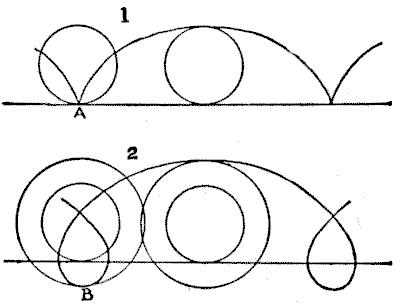
CONCERNING WHEELS.—solution
If you mark a point A on the circumference of a wheel that runs on the surface of a level road, like an ordinary cart-wheel, the curve described by that point will be a common cycloid, as in Fig. 1. But if you mark a point B on the circumference of the flange of a locomotive-wheel, the curve will be a curtate cycloid, as in Fig. 2, terminating in nodes. Now, if we consider one of these nodes or loops, we shall see that "at any given moment" certain points at the bottom of the loop must be moving in the opposite direction to the train. As there is an infinite number of such points on the flange's circumference, there must be an infinite number of these loops being described while the train is in motion. In fact, at any given moment certain points on the flanges are always moving in a direction opposite to that in which the train is going.

In the case of the two wheels, the wheel that runs round the stationary one makes two revolutions round its own centre. As both wheels are of the same size, it is obvious that if at the start we mark a point on the circumference of the upper wheel, at the very top, this point will be in contact with the lower wheel at its lowest part when half the journey has been made. Therefore this point is again at the top of the moving wheel, and one revolution has been made. Consequently there are two such revolutions in the complete journey.
click here to go to my blog.
See more interesting puzzles at http://puzzles.50webs.org